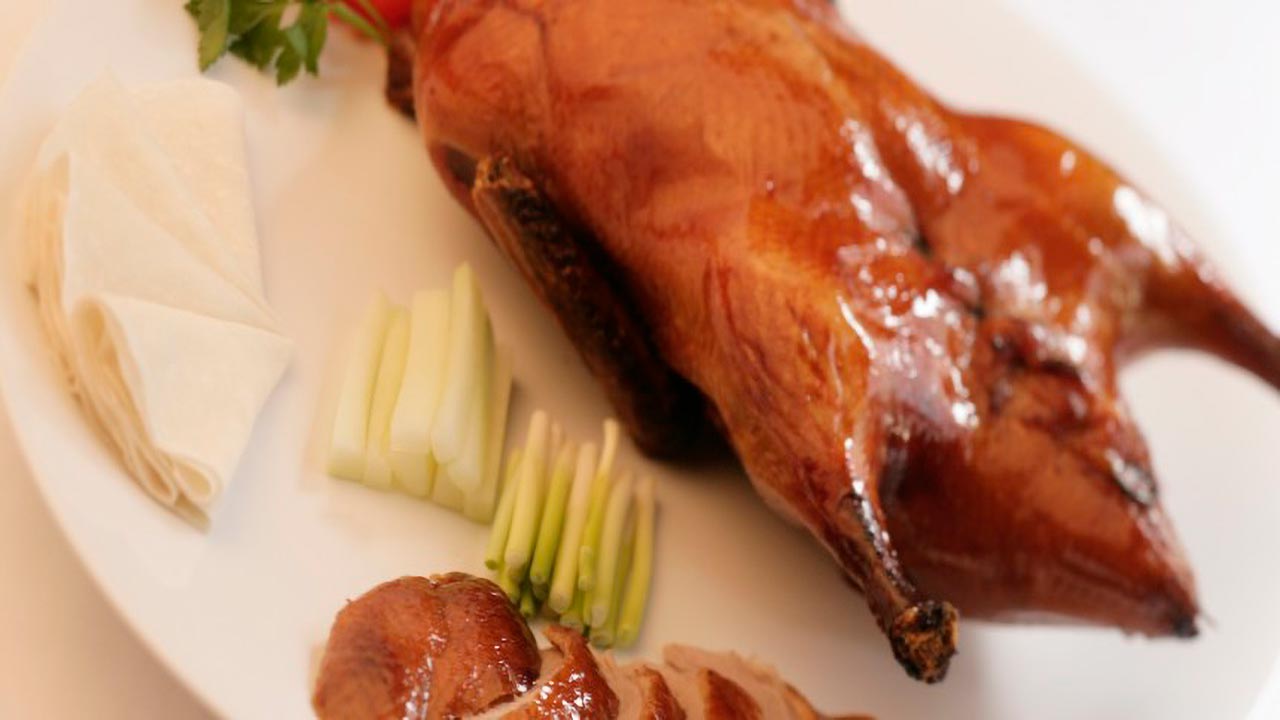Easy Peking Duck Recipe, What about making your own?
We all know Peking duck from trips to the local Chinese restaurant but have you ever thought about making your own? Before you get too excited, you need to know how much work is involved – this is no quick and easy 10-minute recipe.
In fact, it can take several days to make this recipe from scratch. If you are still up for the challenge, keep reading, and discover how to make this delicious treat.
Peking duck offers juicy succulent flesh underneath a crispy, golden skin. It is usually served with thin pancakes, spring onion, cucumber, and hoisin sauce.
A Brief History of Peking Duck
The Chinese have been roasting ducks for hundreds of years but, as is true with many set-piece specialties, the recipe only became famous outside of China when Chinese restaurants aimed at international travelers started to open in the mid-1800s.
Banquet dining on a large scale is an important part of Chinese culture and Peking duck is a popular course at a large celebratory meal, in part because of its amazing flavor, but also because of the long preparation involved and the rituals of service.
The ducks were originally roasted by hanging them in a pot oven, similar to a tandoor after the aromatic wood fuel had finished burning leaving a residual heat along with a touch of fragrant smoke.
A Few Handy Tips Before You Begin
The type of duck usually used in this recipe is the Pekin breed which hails from Nanjing. The skin is not too fatty, the flavor is gorgeous, and the duck itself is a perfect size. Because you will need to hang the duck, invest in a duck hanging hook from a Chinese food shop if you can.
It is just a couple of butcher’s hooks on a metal ring and handles. If you cannot get one, you can fashion one out of a metal coat hanger. You can also buy some maltose when you are there because this is the best thing to make the glaze.
This malt sugar mixture is common in Chinese recipes and it caramelizes nicely, offering a sweet, satisfying taste.
How to Get the Skin Crispy
Peking duck would not be the same if it did not have wonderfully crispy skin, and to achieve this you need to get rid of all the moisture, the skin will not reach a high enough temperature to brown enough.
Dehydration is the first step in preparing Peking duck, and this involves air-drying the duck overnight, either hung up near a fan or in the fridge.
Blowing up the duck is also important, and that can be accomplished with a bicycle pump, air compressor, or simply by pulling the skin away from the meat with your fingers and a wooden spoon handle.
Make sure you get the skin away from the meat on the breast and around the joint where the body meets the thigh. The whole point of this is to get the fat to render off the skin because that helps it to crisp up beautifully, just the way you want it.
The following recipe shows you how to prepare and cook the Peking duck. Serve the finished duck with warmed thin pancakes, cucumber, and spring onions, both sliced thinly, along with hoisin sauce (or plum sauce if you prefer).
Peking Duck Recipe
Ingredients
- Whole Duck – 1
- white vinegar – 150 ml
- salt – 5g
- star anise – 5g
- fresh ginger – 5g
- orange peel – 5g
- cinnamon – 5g
- Sichuan pepper – 5g
- cloves – 2
- maltose or honey – 200 ml
- dark soy sauce – 50 ml
- rice vinegar – 50 ml
- warm pancakes – 16
- cucumber – half, cut into matchsticks
- spring onions – 3, cut into matchsticks
- hoisin sauce or plum sauce – 200 ml
Instructions
- Trim the duck’s legs and wings back to the first joint and discard any fat from the cavity.
- Slide your fingers under the skin and loosen it all over with the aid of a wooden spoon handle.
- Insert a bicycle pump or air compressor to blow the skin loose if you prefer to do it that way.
- Hang your duck on a hook and bring a pot of water to a boil.
- Add the vinegar to the water then take it off the boil and plunge the duck in for 10 seconds.
- Hang the duck back up and let it cool for a minute, then repeat this process 4 more times.
- Grind the salt with the star anise, ginger, orange, cinnamon, pepper, and cloves, and sprinkle this inside the duck’s cavity.
- Hang the duck in front of a fan or leave it uncovered overnight in the fridge, so the skin can dry out.
- Put the maltose, soy sauce, and rice vinegar in a pan with a little boiling water until the mixture is thick and well combined.
- Paint this glaze over the duck’s skin and let it air dry by the fan or in the fridge.
- Repeat this until the coating is dark and sticky.
- Preheat the oven to 200 degrees C.
- Put some boiling water in a roasting tin at the bottom of the oven, and put the duck on a rack above it.
- Turn the temperature down to 160 degrees C as soon as the duck is in there.
- Cook for an hour and a half or until the duck is perfectly done.
- Let it sit for 10 minutes so the glaze can harden and the juices can settle.
- If you want to shred it Chinese restaurant-style, let it cool completely, refrigerate it overnight, and reheat it in a warm oven before using 2 forks to shred the meat.
- If you prefer a more authentic Chinese serving style, serve thin shavings of skin and fat with a little meat attached.
- Serve pancakes, plum or hoisin sauce, spring onions, and cucumber on the side.
- Any leftover Peking duck can be used in a stir-fry the next day.

Embracing the Tradition of Peking Duck
Creating Your Culinary Legacy
Embarking on the journey of crafting your own Peking duck is more than a gastronomic endeavor; it’s a connection to the rich heritage of Chinese cuisine. This delicacy, steeped in tradition and meticulous preparation, presents an opportunity to delve into the intricacies of culinary artistry.
Unveiling the Origins
The history behind Peking duck is as savory as its taste. Originating from ancient Chinese culinary practices, this dish transcended borders and became a globally revered delicacy. Its emergence in international dining was a testament to the prowess of Chinese culinary expertise, resonating with celebratory banquets and cultural significance.
Essential Preparations and Insights
Before venturing into the culinary marathon that is making Peking duck, essential tips illuminate the path ahead. Understanding the significance of the Pekin breed, acquiring the right tools like the duck hanging hook, and discovering the secret of maltose for the glaze form the bedrock of a successful venture into crafting this esteemed dish.
The Quest for Crispy Skin
Central to the allure of Peking duck is its tantalizingly crisp skin. Achieving this culinary feat requires meticulous steps, including dehydrating the duck, using innovative methods to separate the skin from the meat, and ultimately allowing the fat to render, creating that coveted crispiness.
The Culinary Odyssey
The meticulously outlined recipe for crafting Peking duck unveils a symphony of flavors and culinary craftsmanship. From the careful trimming and seasoning to the glazing process and the patient roasting, every step is an ode to the culinary heritage embedded within this revered dish.
Serving Tradition on a Platter
The final act of presenting Peking Duck is a celebration in itself. Whether shredded in the style of Chinese restaurants or served with delicate shavings of skin and fat, accompanied by warmed pancakes, crisp cucumber, spring onions, and the indulgent hoisin or plum sauce, it’s a feast that beckons communal indulgence.
In conclusion, the journey to create Peking duck from scratch is a tribute to culinary finesse, patience, and a reverence for cultural heritage. Beyond the tantalizing flavors, it’s an invitation to embark on a culinary expedition that embodies tradition, history, and a deliciously rewarding labor of love.
Reviews
A Home Chef’s Peking Duck Triumph!
Embarking on the Peking duck adventure was a delightful revelation. The detailed recipe not only demystified the seemingly complex process but also made it approachable for home cooks. The historical background provided a charming context, adding layers of appreciation to the culinary journey. Practical tips, like using a homemade duck hanging hook and the magic touch of maltose for the glaze, turned this kitchen endeavor into a joyous experiment. The quest for the perfect crispy skin became a triumph with ingenious dehydration and fat-rendering techniques. The final presentation, with thin pancakes, cucumber, spring onions, and a luscious hoisin sauce, felt like a culinary masterpiece worthy of any celebratory occasion. This Peking Duck recipe transformed my kitchen into a haven of flavors and cultural exploration.
A Delicious Culinary Adventure: Crafting Your Own Peking Duck
Embarking on the Peking duck-making journey was an absolute delight! This comprehensive guide demystifies the intricate steps involved in creating this revered Chinese delicacy, infusing each phase with enthusiasm and expertise. The historical backdrop offered a fascinating insight into the dish’s origins, adding depth to the culinary experience.
The detailed tips and tricks were invaluable, ensuring a smooth preparation process from start to finish. Achieving that crispy skin was a triumph, thanks to the insightful techniques shared within the recipe. The final result? A succulent and flavorsome Peking duck that wowed both the taste buds and the soul, a testament to the joy of culinary exploration and the satisfaction of a dish well-made!
